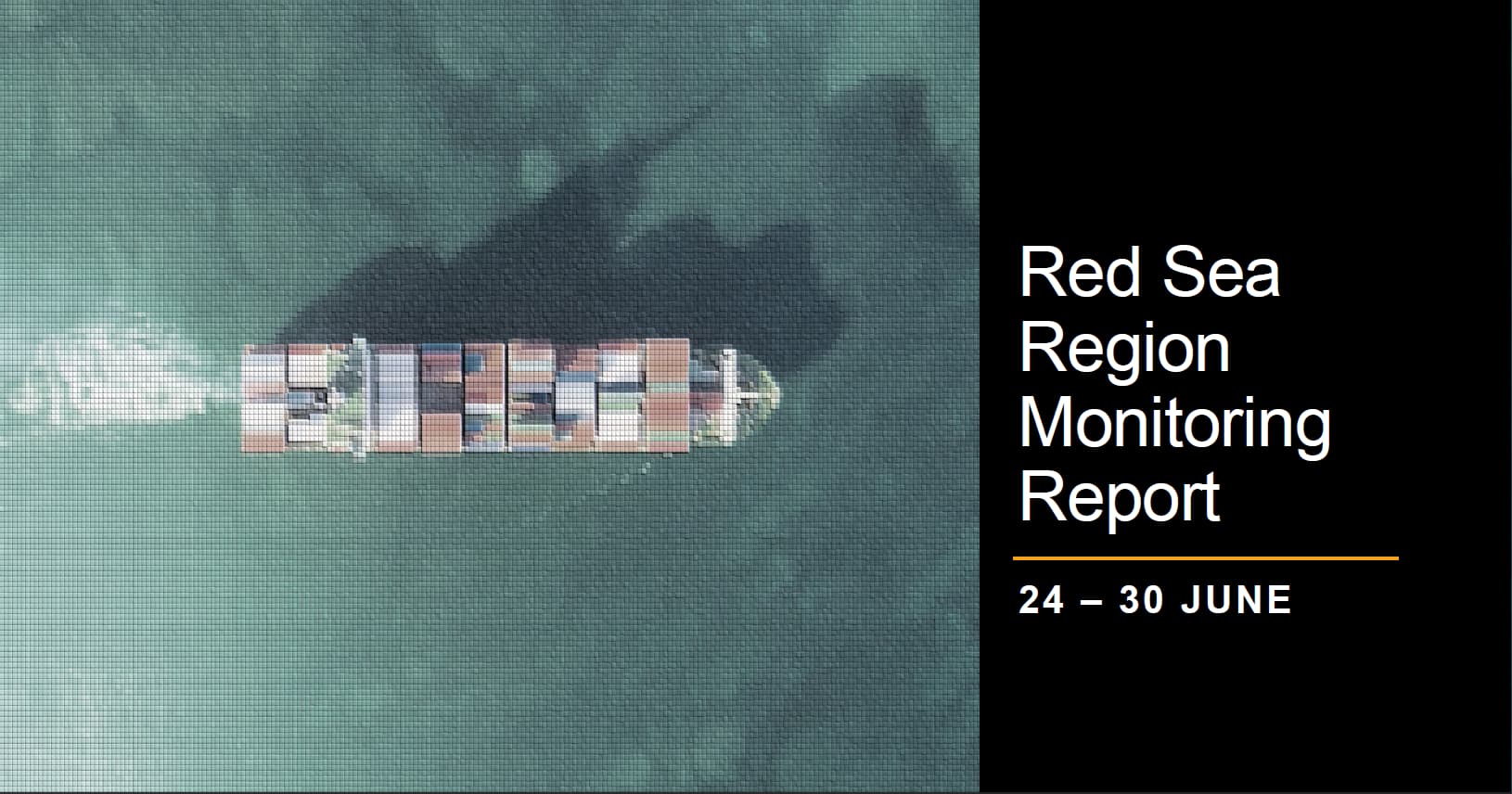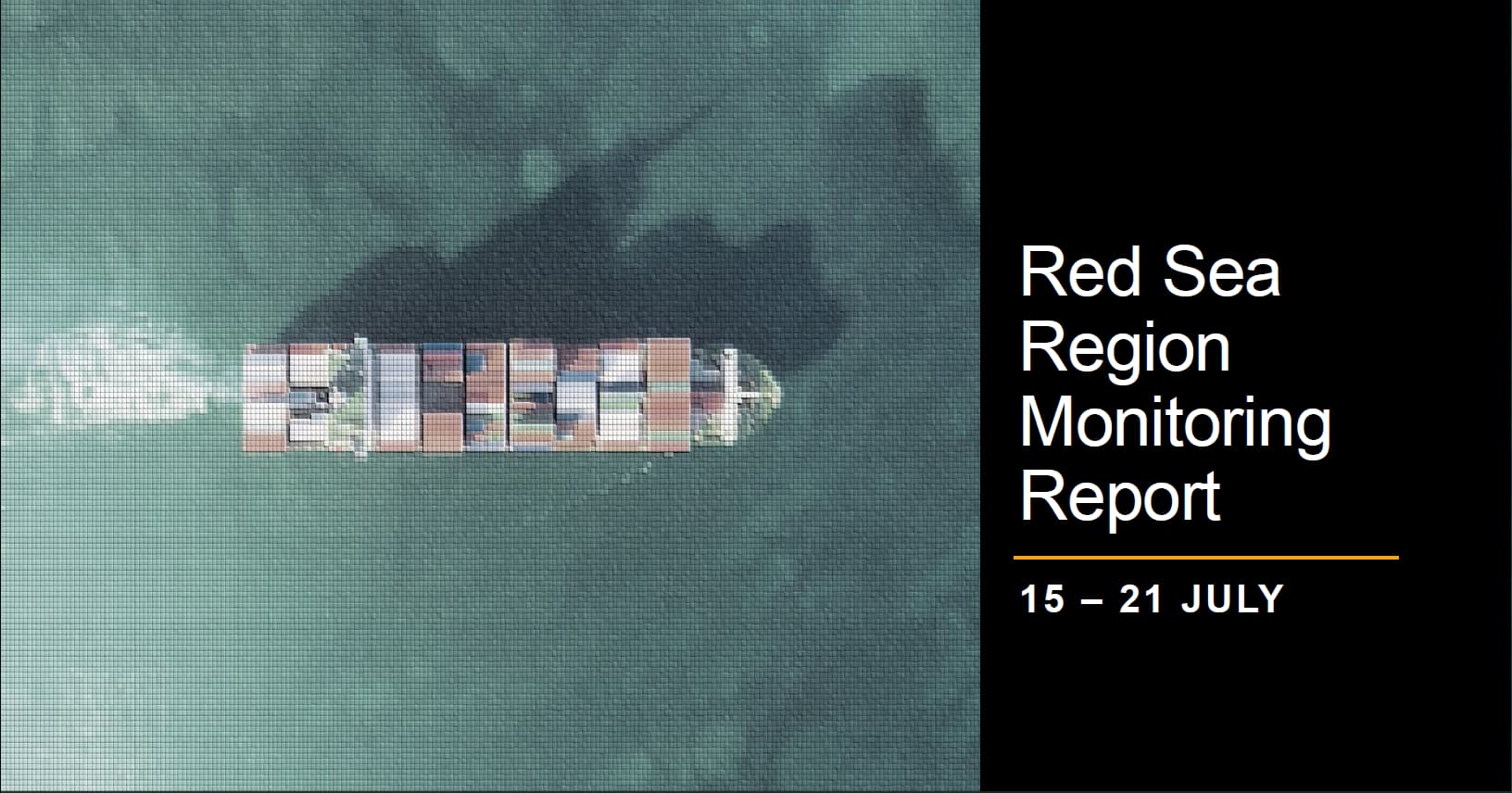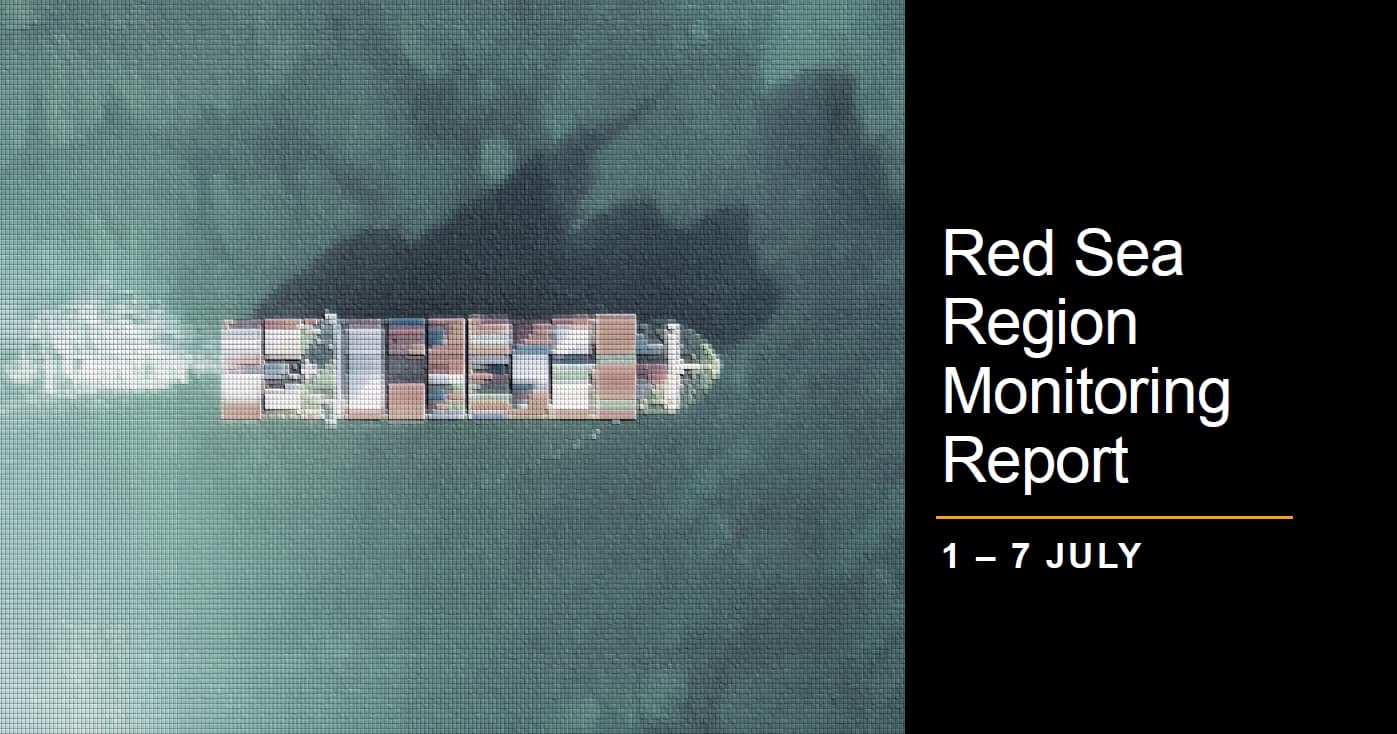KEY DEVELOPMENTS – COMMERCIAL INCIDENTS
During the monitoring period 6 – 12 May Regal Maritime Solutions (RMS) identified the following incidents in the Red Sea and Gulf of Aden region:
MISSILE ATTACK: On 7 May an incident was reported 82NM south of Aden, Yemen after Houthi militants unsuccessfully targeted both the MSC Gina and MSC Diego. Two explosions were reported in close proximity to one of the vessels. The crew and vessel were reported safe and unharmed.
PIRACY INCIDENT: On 10 May in the Gulf of Aden, a Somali Pirate Action Group (PAG) attacked the Marshall Islands-flagged Chrystal Arctic. Pirates aboard a small vessel carrying ladders, Kalashnikov-style rifles and rocket-propelled grenades opened fire on the tanker. The Chrystal Arctic’s onboard armed security team returned fire resulting in the PAG to abandon their attempt to hijack the vessel. There were no reported damage or injuries to the crew of the Chrystal Artic. A few hours later a European Union naval force (EUNAVFOR) under Operation Atalanta intercepted the suspected pirate vessel and detained six suspected pirates some of whom had injuries of varied severity. The suspects allegedly from Somalia were treated and then taken to the Seychelles to face legal proceedings. The Chrystal Artic continued on its voyage.
IRANIAN INTELLIGENCE VESSEL: There have been no updates on the Iranian intelligence vessel the Behshad during the reporting period. Its last reported location was on 18 April in the Persian Gulf in Ira nian territorial waters.It was located in the vicinity of coordinates 26° 59′ 26.2″ N, 056° 24′ 35.2″ E located approximately 5NM south of Banda Abbas, Iran and south west of the island of Hormuz.

KEY DEVELOPMENTS – MILITARY ACTIVITY
During the monitoring period 6 – 12 May RMS identified the following incidents involving US coalition forces in the Red Sea and Gulf of Aden region, obtained from military and open sources:
UAV INTERCEPT: On 6 May around 1047 local time United States (US) forces engaged and destroyed one uncrewed aerial vehicle (UAV) launched by Houthi militants over the Red Sea. The UAV was determined as presenting an imminent threat to vessels in the region.
UAV INTERCEPT: On 7 May between 2300 and 2350 local time, Houthi militants launched three UAVs over the Gulf of Aden from Houthi controlled areas in Yemen. A coalition ship successfully engaged one UAV, whilst US forces successfully engaged the second UAV. The final UAV crashed in the Gulf of Aden. There were no reported injuries or damage to US, coalition or commercial vessels.
MISSILE ATTACK: On 7 May at approximately 0500 local time, Houthi militants launched an anti- ship ballistic missile (ASBM) over the Gulf of Aden. There were no injuries or damages to any vessels in the area.
UAV INTERCEPT: On 10 May at approximately 2045 local time, Houthis militants launched an UAV over the Gulf of Aden from Houthi controlled areas in Yemen. The UAV was subsequently engaged by a coalition aircraft and destroyed without incident.
UAV INTERCEPT: On 11 May between 0430 and 0445 local time, US forces successfully destroyed three UAVs launched by Houthis militants over the Red Sea from Houthi controlled areas in Yemen after the UAVs were considered and imminent threats to US and coalition warships in the region and commercial shipping. There were no reported injuries or damages by vessels in the region.
UAV INTERCEPT: On 12 May at approximately 0330 local time US forces successfully destroyed a UAV launched by Houthis militants over the Gulf of Aden from Houthi controlled areas in Yemen. No injuries or damages were reported by US, coalition, or commercial vessels.

KEY DEVELOPMENTS – HOUTHI MISSILE STATISTICS

Figures 1 and 2 identifies the number of missiles, UAV, USVs and UUVs launched, or prepared to be imminently launched, by Houthi militants from Yemen targeting commercial and naval vessels in the Red Sea and Gulf of Aden regions. Figures have incorporated statistics from vessels hit, near misses and pre- emptive strikes on-land in Yemen by US-led Coalition forces but not those resulting from large scale coordinated military action. In some cases the destined target of Houthi weapons including destroyed on-land in Yemen cannot not be verified and has therefore been categorised as ‘Not Known’ (NK). Where no dates are provided there were no reported incidents or data available for that period.
ANALYSIS: Houthi missile and UAV launches over the reporting period continues at a lower but steadier pace than over previous weeks, with Houthis relying more on UAV attacks rather than missile attacks. This may potentially be as a consequence of easy access to UAV weapon components in Yemen than those those required for anti ship and ballistic missiles.
KEY DEVELOPMENTS – SECURITY INCIDENT MAPPING

REGIONAL DEVELOPMENTS
During the monitoring period 6 – 12 May RMS identified the following key regional developments:
Israel-Hamas negotiations continue to face challenges with little to no progress made over the last week, with Egypt citing that both sides needed to show greater “flexibility”.
Israel have been applying increasing military pressure on Rafah in southern Gaza in the hope of eliminating the remaining Hamas battalions and securing the release of further hostages.
The US continues to express concerns that Israel has not “fully addressed” the humanitarian needs of civilians in Rafah. As a consequence, the relationship between the US and Israeli government showed further signs of deterioration after the US Defense Secretary confirmed on 8 May that the US would be pausing a shipment of “high payload munitions” to Israel, due to concerns it may used in Israel’s planned ground operation in Rafah. The delay in the shipment comes as US President Joe Biden faces mounting domestic pressure to reconsider military support for Netanyahu
In Israel, anti-government demonstrations have continued to grow in size and numbers, as more time increasingly passes with hostage and peace deals failing to materialise.
Iran backed groups such as the Islamic Resistance in Iraq continue to attack Israeli territory after confirming the launch of a on way attack drone which was successfully intercepted by the Israeli Airforce in the east of the country.
Kamal Kharrazi, key advisor to Supreme Leader Ayatollah Khomeini, indicated that Iran will change its nuclear doctrine if the country feels threatened in any way by Israel. Although the Iranian government claims to have no plans to obtain nuclear weapons, Kharrazi claimed the country possess the capability to create a nuclear bomb if needed. Iran’s nuclear program has been at the centre of disputes resulting in sanctions and tensions amongst members of the international community.
In response to the Houthi’s targeted attack of the Israeli-linked containership MSC Orion on 27 April, the EU Naval Force (EUNAVFOR) Operation Atalanta released updated guidance on 11 May for commercial vehicles transiting at least 150 nautical miles further east from current shipping routes. The updated guidance advises maritime operators to implement random course alternations, speed changes and “a more restrictive” location broadcast policy.
In addition to the Houthis unsuccessful attacks on the MSC Gina and MSC Diego on 7 May, the Houthi group claimed to have targeted and damaged the MSC Vittoria after the group indicated it had targeting it in both the Indian Ocean and then in the Arabian Sea. So far the claims remain uncorroborated as no event has yet been reported of such an incident. The Houthi suggestion they have targeted another vessel in the Indian Ocean following the UAV attack on the MSC Orion a week earlier indicates the groups’ continued ambitions to target vessels beyond their traditional target area of the Red Sea, Bab Mandeb strait and the Gulf of Aden.
ASSESSMENT
- Houthi attacks will continue to target commercial and military vessels in the Red Sea and Gulf of Aden and seek to target shipping further afield in the Indian ocean and Arabian Sea. This will be limited on Houthi weapon capability, availability and opportunity. The expanded risk zone will result in further disruption to maritime logistic lines.
- Whilst Houthi threats and ambitions to target vessels in the Indian Ocean, the risk from a successful long-range attack is less likely, compared to vessels being targeted in the Red Sea and Gulf of Aden, with most attempts likely failing to reach the intended target. Nonetheless, Houthi capability and intent is sufficient to continue to disrupt shipping routes in the expanded area as shipping companies incorporate advised mitigation measures and adapt routes accordingly.
- Vessels linked to Israel, the US and UK will remain primary, but not sole targets for Houthi militants. The Houthis will continue to be cautious not to target vessels associated to China and Russia.
- Iran will continue to support its proxies to avoid direct confrontations with Israel and will continue to provide weapon and weapon components in support of Houthi attacks on Israeli, US and UK linked vessels. Iran will continue to smuggle weapon components to Houthi militants via shipping vessels and smuggling networks.
- Iranian-backed proxies in the region maintain the capacity for unilateral action, and thus escalatory actions cannot be entirely ruled out.
- An intensification in the ground offensive in Rafah by the Israeli Defense Forces (IDF) will likely result in increased in Houthi attacks against commercial shipping in the Red Sea region and potentially further afield, again, limited by their weapons systems and availability. Any ceasefire between Israel and Hamas, may see a temporary pause in attacks by the Houthis.
- The US and its partners will continue to conduct pre-emptive strikes against Houthi targets on-land in an attempt to degrade Houthi military capability and prevent it to be used to target commercial shipping and from being used as a platform to target Israel.
- The US will continue to intensify efforts to intercept vessels smuggling weapon components from Iran to the Houthis in Yemen and expand intelligence collection methods to enhance maritime interdiction operations, as well as coordinate military strikes against Houthi weapon sites, facilities and capabilities in Yemen.
- The US government will continue to push for a diplomatic solution for the Israel-Hamas conflict with regional partners due to the ongoing humanitarian crisis in Gaza and attempt to dissuade wider conflict from escalating in the region and an Israeli offensive in the Gazan city of Rafah.
- The threat from piracy action groups (PAGs) around the Horn of Africa and Indian ocean continue to pose a threat to commercial shipping.
RECOMMENDATIONS
- Avoid being in vicinity of Iranian Behshad vessel. Avoid where possible transiting locations within the UAE and Iranian coastlines due to the risk from Iranian military boarding parties.
- Be aware of US, coalition or Israeli Navy activity in the Red Sea, Bab-al-Mandab strait and Gulf of Aden, as well as Iranian activity in the Arabian sea.
- Vessels operating in the Indian Ocean area are urged to heighten their vigilance due expanded risk area from Houthi missile and UAV attack and continued threat from Pirate Activity Groups (PAGs) in the area.
- Report any Suspicious Sightings and be aware of the risk of Unmanned aerial Vehicle (UAV) / drone and Uncrewed Surface Vehicle (USV) attack.
- Consider utilising a digital monitoring system, which incorporates UAV/UUV drone monitoring to warn of potential attack and use of physical barriers, such as nets and underwater barriers, that can be deployed to prevent UUVs from approaching a ship. These barriers can entangle or obstruct the movement of a UUV..
- Ensure crew conduct drills and training exercises to respond to UUV threats so that they are well-prepared to take appropriate action in the event of an incident.
- Follow guidance on loitering munitions as per the OCIMF website: https://www.ocimf.org/publications/information-papers/loitering-munitions-%E2%80%93-the-threat-to-merchant-ships
- Implement and review BMP5 in particular section 2, which describes non-piracy threats and the Global Anti-Piracy Guide.
- Consider mentioning vessel location to Flag Authorities.
- Inform UKMTO/MSCHoA of vessel movements and ensure radar is kept on.
- Communicate with local agents for any local information or intelligence.
- Keep VHF Ch16 on and pay attention to advisories. Ensure strict surveillance of communications and establish communication with all approaching vessels.
- Do not allow small boats to approach or dock. Consider utilizing an armed security team aboard.
- Ensure there is Hard Cover available if on deck and that it is accessible.
- Ensure a Secondary Muster Station is considered and identified to crew and not just the citadel.
- Maintain Bridge Watches. (Please be aware at night, small, slow vessels without a wake are difficult to detect on radar). Keep Traffic on Upper Deck to a minimum
- Ensure all fire-fighting equipment is checked and available for immediate use. Including the emergency fire pump and that relevant maintenance has been conducted.





